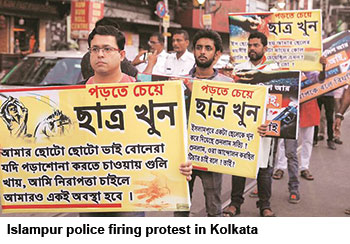 The political power and influence of the students’ community in the eastern seaboard state of West Bengal (pop.91 million) has been historically acknowledged right from the heyday of the anarchic Naxalite movement of the 1970s — often romanticised as the golden age of student politics in Bengal. Moreover in Bengal, Gandhian non-violence made minimal impact with the great majority preferring the armed struggle option undertaken by the state’s icon Subhash Chandra Bose. Therefore students’ agitations and demonstrations from the 1970s under Congress rule and subsequently during the uninterrupted 34-year rule of the CPM (Communist Party of India-Marxist)-led Left Front in West Bengal (1977-2011) invariably involved the use of violence, with student unions running amok within the state’s 25 universities and 374 colleges.
The political power and influence of the students’ community in the eastern seaboard state of West Bengal (pop.91 million) has been historically acknowledged right from the heyday of the anarchic Naxalite movement of the 1970s — often romanticised as the golden age of student politics in Bengal. Moreover in Bengal, Gandhian non-violence made minimal impact with the great majority preferring the armed struggle option undertaken by the state’s icon Subhash Chandra Bose. Therefore students’ agitations and demonstrations from the 1970s under Congress rule and subsequently during the uninterrupted 34-year rule of the CPM (Communist Party of India-Marxist)-led Left Front in West Bengal (1977-2011) invariably involved the use of violence, with student unions running amok within the state’s 25 universities and 374 colleges.
High hopes were generated within the state’s beleaguered academics after the Mamata Banerjee-led Trinamool Congress (TMC) routed the CPM in West Bengal’s assembly election in the summer of 2011, that she would fulfill her election promise of bringing poriborton (“positive change”) and stability to the state’s rundown institutions of higher education. Seven years on, it’s becoming increasingly clear that instead of breaking with the CPM leadership’s policies of encouraging politicisation of the academy, TMC under Banerjee’s leadership is emulating it.
Incidents of rampant campus violence, mass copying and teacher recruitment and testing scandals have become commonplace in West Bengal’s academy as the ruling party’s students’ wing, the Trinamool Chhatra Parishad is stridently attempting to dislodge strongly entrenched students and teachers unions owing allegiance to the CPM. And in clashes between rival students unions, the state’s trigger-happy police is frequently summoned to fire on students of CPM-affiliated unions.
On September 20, a violent clash broke out between a mob and the police in Islampur in the North Dinajpur district over the issue of appointment of teachers in a government school, which resulted in two alumni of the school being shot dead and several others suffering injury. However, police denied any role in the killing, saying they had used batons and fired tear-gas shells and rubber bullets.
This is the second incident under TMC rule in which police aggression has resulted in student deaths. In 2013, Sudipto Gupta, a 22-year-old postgraduate student and leader of the CPM-affiliated Students Federation of India (SFI), succumbed to injuries sustained in police custody. The SFI leader was among hundreds of students protesting against the government’s decision to postpone college union elections.
On a 15-day tour of Germany to attract foreign investment into West Bengal at the time of writing, chief minister Mamata Banerjee has accused the Rashtriya Swayamsevak Sangh (RSS) — the militant ideological mentor organisation of the ruling BJP at the Centre, which is making a strong bid to replace the CPM as the alternative political party of West Bengal — of indulging in a “dirty game” over the Islampur incident. “The RSS is playing a dirty game after the Islampur police firing. Action will be taken against those inciting violence. If anyone from the police is found to be at fault, stern action will be taken,” she said. Even as Dilip Ghosh, president of BJP’s West Bengal unit, promptly denied the allegation, tension continues to simmer in the district as relatives of the victims have refused to cremate the bodies until the state government orders a CBI probe.
The Islampur police firing which is snowballing into a major political issue is complicated by the larger issue of teacher recruitment in West Bengal’s government schools. Even as there is an acute shortage of teachers estimated at 88,000 in the state’s 92,000 government schools, these vacancies haven’t been filled because the CPM alleges that the TMC government has fudged recruitment rules and procedures to pack schools with TMC loyalists.
After the TMC was voted to power in 2011, teacher recruitment in the state was completely frozen for five years because of court stay orders and enquiry commissions. And even though 50,426 teachers have been recruited for primary schools and 27,572 for upper primary, secondary and higher secondary schools, protest marches and agitations alleging irregularity and favouritism in the selection process, test papers leakage and flouting of NCTE (National Council for Teacher Education) guidelines, have become commonplace.
Meanwhile, several influential academics express shock at the blatant misuse of the police machinery against students by the TMC government, and have severely condemned the shooting of students in Islampur for demanding filling of teacher vacancies. Comments Niharendu Choudhury, secretary of the West Bengal Head Masters Association: “The ongoing unrest in North Dinajpur and police brutality against innocent students demanding clarity in the teacher recruitment process has severely damaged Mamata Banerjee’s image in West Bengal even as she prepares for a larger role in national politics. She should first deliver the promised poriborton in education or her base is likely to crumble.”
Evidently the promised poriborton and renaissance of the academy of West Bengal — India’s most respected until the infusion of Naxal and communist ideologies into the state’s campuses in the 1970s — is a long way away.
Baishali Mukherjee (Kolkata)



























